Over recent years, more and more studies have been released detailing the advantages of altitude training and the disadvantages of altitude training. There is more research than ever before into the effects of high altitude on the human body, as athletes increasingly want to learn about this phenomenon.
When discussing altitude training, skiing is often brought up for a couple of reasons. One is that skiing normally takes place at higher altitudes and it can be useful to have done some kind of altitude training before competing in skiing competitions. Another is that athletes in other sports may go on a skiing holiday as a fun way of obtaining the benefits of altitude training for use in their own sport.
In this guide to the benefits and disadvantages of altitude training, we’ll explain the effects of altitude training and get to grips with the question of what is altitude training. With all of this, it’s important to note the potential risks and effects of altitude training, and to consult a doctor if you’re not sure whether altitude training is something you should be considering.

Altitude training: How does altitude training work and how effective is altitude training?
It is well-known that being at a higher altitude, meaning more metres above sea level, takes a toll on humans. The effects of high altitude on the human body are that, with less oxygen in the air, your body has to breathe more to get the same amount of oxygen pumping through the body. Having to breathe more for just the same result strains many parts of the body. But, as with any other exercise, this strain can force your body to get stronger and to deal with this better over time.
Altitude training is the term for the way humans put their bodies through a brief period of higher altitude in order to get stronger. There is also a physiological response, as one of the effects of high altitude on the human body is an increased production of erythropoietin, which stimulates red blood cell production. With repeated exposure to high altitudes, an athlete’s body can keep a high amount of erythropoietin for some time, which should improve endurance even at sea level.
Why athletes use altitude training: What are the advantages of altitude training for athletic performance?
The last point from the above section is the fundamental answer to the question of ‘Why do athletes use altitude training?’. Obtaining a higher concentration of red blood cells can be a major boost for an athlete in terms of athletic performance. An overall strengthening of the respiratory system is also possible and is another of the long-term advantages of altitude training.
Altitude training examples: Does skiing give you the benefits of altitude training?
Skiing is an interesting sport when it comes to altitude training, as it both requires a certain level of altitude acclimatisation to perform optimally while it can also act as a high altitude training exercise for athletes of other sports.
Practicing skiing does give you the benefits of altitude training if it is taking place high enough above sea level, which is naturally the case with most ski resorts. The ski slopes in Andorra can reach around 2,500m above sea level, which is a good level for altitude training, even if it’s still a little below what is considered high altitude training.
Besides skiing, other altitude training examples include sports such as cycling or running high above sea level. In most cases, a person will spend some time living and training at this high altitude, to properly get accustomed to it.
Advantages of altitude training: What are the immediate effects of altitude training? How long do altitude training benefits last?
In general terms, the advantages of altitude training include better breathing, better oxygen transport and higher anaerobic resistance. It is also believed there can be a one to five percent improvement in performance at the lactic threshold.
The immediate effects of altitude training are soon lost after returning to sea level, with the increase in red blood cells being lost in about 15 days. However, there are some long-term advantages of altitude training, such as improving your endurance during intense exercise.
Disadvantages of altitude training: What are the negative effects of altitude training?
You’ve probably heard of altitude sickness, which is one of the potential disadvantages of altitude training. The symptoms of altitude sickness include headaches, tiredness, nausea and vomiting.
Meanwhile, there are several critics of altitude training, who claim that trying to disrupt your body’s natural processes can be a dangerous game and that the short-term gains may then make it more difficult to readapt at sea level. So, going back to a point made earlier in this article, you should really take the time to look into what is altitude training and whether it is right for you.
